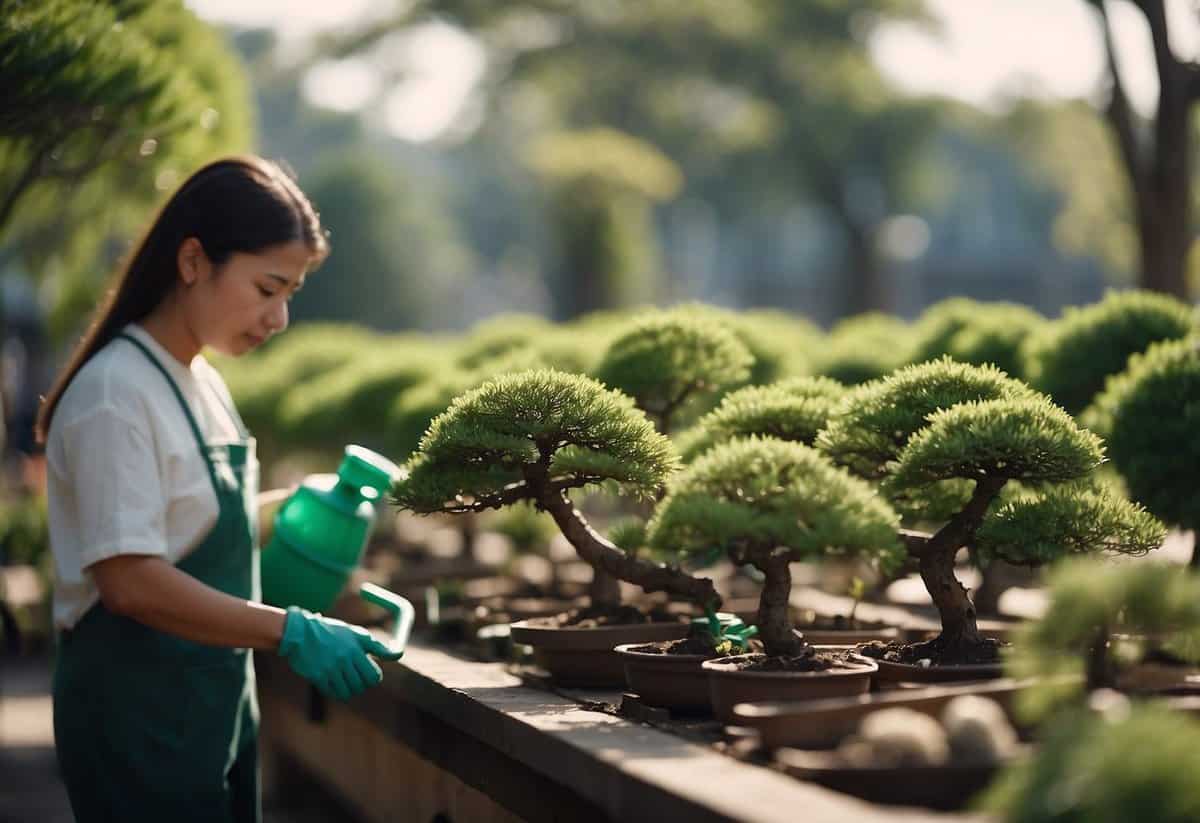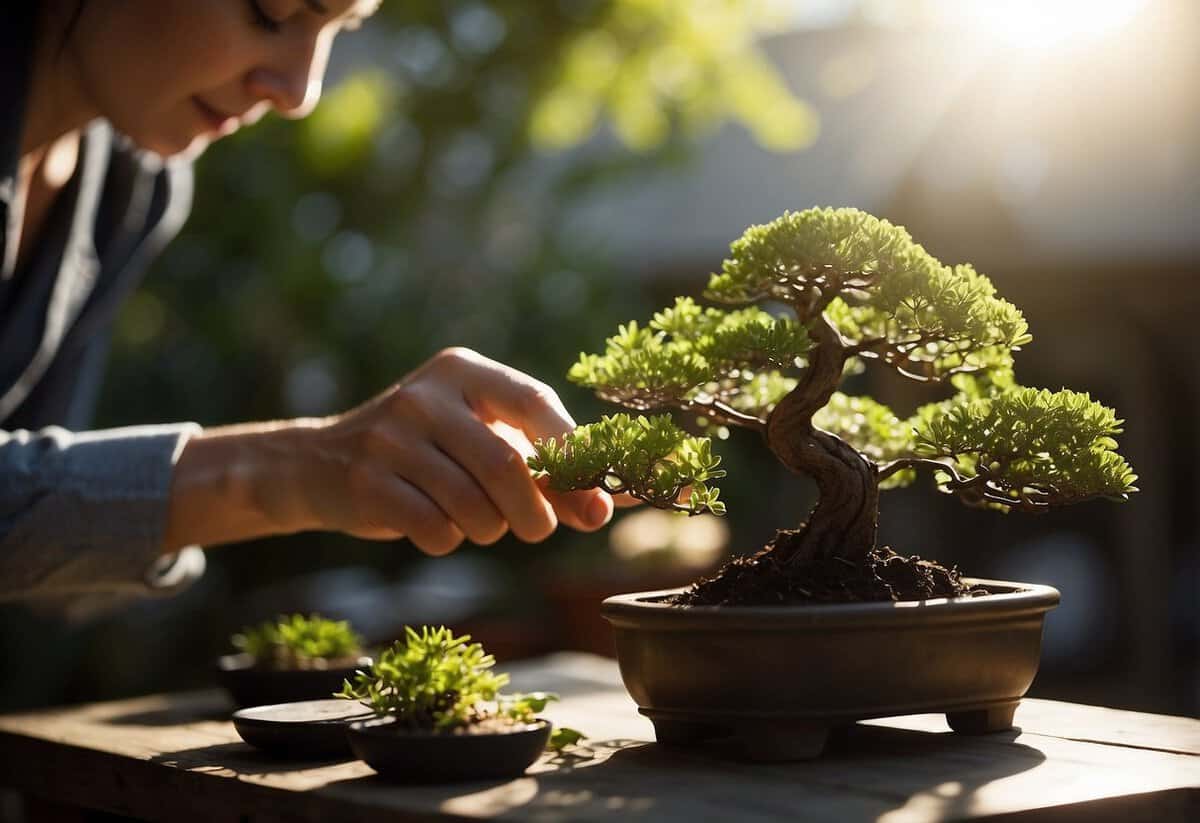Bonsai Garden Tips: Easy Ways to Enhance Your Miniature Tree Collection
Creating a bonsai garden can be a rewarding and peaceful hobby. It involves cultivating miniature trees in small containers to mimic the shape and scale of full-sized trees. With the right knowledge and care, you can grow a beautiful bonsai garden that brings joy and tranquility to your space.

Caring for bonsai trees requires patience, attention, and a willingness to learn. Whether you are just starting out or have some experience, there are always new techniques and tips to explore. Designing and maintaining a bonsai garden allows you to express your creativity while connecting with nature.
1) Choose the Right Species

Selecting the right bonsai species is crucial. Different trees have different needs.
Ficus trees, for example, are a popular choice for beginners. They prefer bright, indirect light and can adapt well to indoor conditions.
Make sure the species you pick can thrive in your environment. Consider the temperature and humidity of your area. A good fit makes for a happy, healthy bonsai.
2) Proper Lighting Conditions

Bonsai trees need the right amount of light to grow well. Place your bonsai closer to a window to ensure it gets enough sunlight. If you have subtropical or tropical bonsai trees, consider using LED grow lights or full spectrum fluorescent lights for better results.
Light is crucial for plant growth. Try to give your bonsai the best light and temperature conditions. Make sure your bonsai gets light for as many hours as possible each day. This helps the tree stay healthy and strong.
3) Watering Technique

Watering your bonsai tree is important. Fill a basin with room temperature water and submerge the bonsai pot. Ensure it’s fully underwater for about 5-10 minutes. Look for bubbles to rise, showing the soil is saturated.
You can use a moisture meter to check soil levels. When the meter reads “3” or “moist,” it’s time to water.
For specific types like pine trees, let the soil dry out slightly between waterings to avoid root rot. Check the soil about one centimeter deep, and if it’s dry, water the tree.
Be gentle and observant with your bonsai’s needs. Happy watering!
4) Pruning and Trimming

Pruning your bonsai tree is key to keeping it healthy and looking good. Start by gathering sharp, clean pruning shears or scissors. These tools are designed for the job and make it easier.
Identify branches and shoots that have outgrown the desired shape. Trim them back to maintain the tree’s shape and encourage growth. It’s fine to prune your bonsai regularly. This helps control the size and renew the foliage, ensuring a vibrant bonsai.
Removing dead or unhealthy branches also promotes overall health. Don’t rush the process. Take your time and enjoy the activity.
5) Repotting Regularly

Repotting your bonsai is important to keep it healthy. Aim to do this every two to three years.
When repotting, first remove the bonsai from its pot gently. Loosen the soil and trim any overgrown roots.
Add a layer of gravel or expanded clay at the bottom of the new pot. Then, fill it with a specialized soil mix. Hold the tree in place and fill the rest of the pot with soil. Water thoroughly afterward.
For more details, you can check this Beginners Guide to Repotting Bonsai.
6) Soil Composition

Choosing the right soil for your bonsai is crucial. Bonsai soil is different from regular garden soil. It needs to provide good drainage, aeration, and water retention.
A popular mix includes one-third akadama, one-third pumice, and one-third lava rock. This combination helps maintain the health of your bonsai tree by ensuring proper water balance.
You can also add organic matter like peat moss or compost. These components help retain moisture and provide essential nutrients. For more tips, check out this guide.
7) Fertilizing Schedule

To keep your bonsai healthy, it’s essential to follow a good fertilizing schedule.
You should start with a lower concentration of fertilizer. It’s better to gradually increase the amount rather than risk over-fertilizing.
A balanced blend of nutrients will help your bonsai thrive. For best results, use a slow-release organic fertilizer like BioGold.
8) Pest Control

To protect your bonsai from pests, start by isolating any infested trees. This stops pests from spreading to other plants in your garden.
Use natural remedies like neem oil or insecticidal soap for effective control. These methods are safe for your bonsai and the environment.
For more severe infestations, try diatomaceous earth, which dehydrates and kills pests.
For more information, read this guide to removing bonsai pests.
Keep an eye on your bonsai regularly to catch any pest problems early.
9) Shaping and Styling

Shaping and styling your bonsai tree is a creative process. You’ll use techniques like pruning and wiring to achieve the desired look. Start by removing any dead or diseased branches.
Pruning helps shape the tree and keeps it healthy. Make clean cuts close to the trunk for proper healing.
Wiring helps you bend branches into the shapes you want. Use one piece of wire to shape two nearby branches. This provides stability, especially for thin branches. Always tie the wire around the branch before bending it.
Different styles like the Formal Upright or Literati add unique characteristics to your bonsai garden.
10) Wiring Branches

Wiring branches is key to shaping your bonsai tree. Start by using wires that are about one-third the thickness of the branch. This ensures they are strong enough to hold the branch in place.
When wrapping the wire, begin at the trunk and work your way to the tips. This method helps anchor the wire firmly.
After a few months, carefully remove the wire to check for any scarring or damage. If needed, prune the branch to maintain its shape.
Following these steps will help you achieve a beautifully shaped bonsai.
Choosing The Right Bonsai Tree

Selecting a bonsai tree is key to starting your bonsai garden. To get this right, you need to know about different species and pick a tree that suits your environment.
Understanding Different Species
There are many species of bonsai trees, each with its own look and care needs. One popular choice is the Japanese Maple which has beautiful leaves that change color with the seasons. This tree is good for moderate climates.
If you prefer an indoor bonsai, the Ficus might be a great choice. Ficus trees are hardy and can tolerate low light levels, making them ideal for indoors. Another indoor option is the Jade Plant, known for its thick leaves and easy care.
Outdoor bonsai, like the Juniper and Pine, need lots of sunlight. Junipers are evergreen and can be shaped easily, while Pines require patience as they grow slowly but can live for many years.
Research and choose a tree you can care for based on your experience and available time.
Selecting Based On Environment
Your local environment greatly affects which bonsai tree to choose. If you live in a place with cold winters, select a hardy tree like the Juniper. These trees can survive freezing temperatures.
For warmer climates with lots of sun, plants like the Bougainvillea thrive well. These vibrant outdoor trees handle heat well and add a pop of color to your garden.
Indoor needs differ. Homes with good humidity and moderate light can accommodate trees like the Ficus. For drier indoor settings, a Jade Plant is a good option.
Consider your house’s space too. Small spaces need smaller bonsai, like miniatures, while large spaces can host bigger trees which require more care.
By knowing your environment, you can pick the right tree that not only survives but thrives, adding beauty and serenity to your space.
Bonsai Garden Maintenance

Maintaining a bonsai garden involves specific watering techniques and carefully selected soil and fertilization practices. These ensure your bonsai trees remain healthy and thrive in their miniature forms.
Watering Techniques
Proper watering is crucial for bonsai trees. They need the right amount of water to stay healthy.
Water your bonsai early in the morning or late in the afternoon to avoid water evaporation. Use a watering can with a fine nozzle to prevent disturbing the soil.
Check the soil daily. Ensure it’s moist but not waterlogged. Test by inserting a chopstick into the soil. If it comes out dry, it’s time to water. Ensure water drains from the bottom of the pot to avoid root rot.
During hot seasons, you might need to water twice a day. In cooler seasons, adjust accordingly, avoiding overwatering.
Soil And Fertilization
Choosing the right soil mix is essential. Use a blend that offers good drainage and aeration coupled with moisture retention.
A typical bonsai soil mix includes akadama, pumice, and lava rock. These components ensure your tree’s roots receive enough air and nutrients.
Fertilize your bonsai trees regularly during the growing season. Use a balanced liquid fertilizer every two weeks. For optimal results, use specialized bonsai fertilizers available at gardening stores.
Avoid fertilizing when the tree is dormant. Too much fertilizer can damage the roots, so follow the instructions on the fertilizer package.
Proper soil and fertilization practices will keep your bonsai trees well-nourished and vibrant.
Styling And Pruning Your Bonsai

Styling and pruning are essential to maintain the shape and health of your bonsai tree. You’ll need specific tools and techniques to achieve the desired look.
Basic Pruning Methods
Pruning keeps your bonsai healthy and in shape. Start by gathering your tools: sharp pruning shears, concave cutters, and wire cutters are essential. First, identify what needs pruning by looking for branches that are too long, crossing, or growing in unwanted directions. Cut these branches back to 2 or 3 leaf nodes.
Regular pruning will encourage even growth. Prune regularly, but take care not to over-prune. This helps the tree distribute growth more evenly, promoting a balanced shape. Maintenance pruning helps keep the tree’s shape consistent by trimming new growth.
Advanced Styling Ideas
Once you’ve mastered basic pruning, try advanced techniques. Wiring branches lets you bend and shape them into desired positions. Use wire specifically designed for bonsai to avoid damaging the tree.
Shape your bonsai by selecting strong branches that define the overall structure. Balance root pruning with branch pruning to keep your tree healthy and stress-free. Thoughtful pruning and wiring can transform your bonsai into a unique work of art. Invest in quality tools for precision and ease.
Explore tutorials and guides to further improve your skills, like this step-by-step guide. The key is patience and practice.







